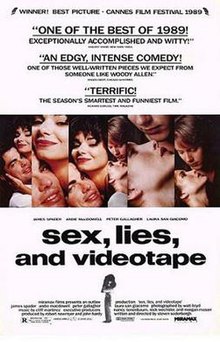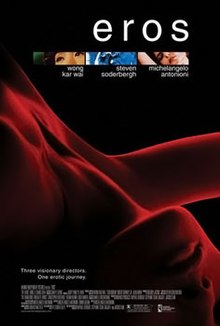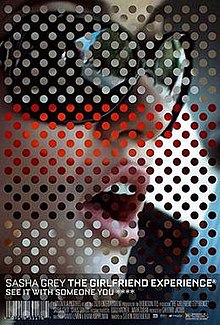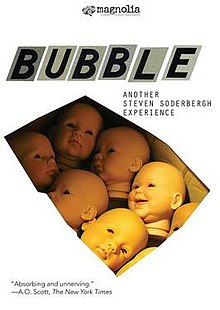The following article was written as an assignment for the Introduction to Film and Video Analysis class.
Steven Soderbergh is one of the most successful directors in the U.S. today. He won the Best Director of the Academy Award in 2000 with Traffic and has many Oscar nominated films such as Out of Sight (1998), Erin Brockovich (2000), and The Good German (2006). After his first film "Sex, Lies, and Videotape" (1989), he has directed many big-budget Hollywood films like the trilogy of Ocean's series (2001, 2004, and 2007) and two parts of Che (2008). On the other hand, he also continues to direct many experimental films with non famous actors or amateurs with small budgets. This type of films includes Sex, Lies and Videotape, Full Frontal (2002), Equilibrium (2004. One of the three short films in a movie Eros), and The Girlfriend Experience (2009). Many of the cinematography in these films have actually been adopted later into his big-budget Hollywood films. In these four art-house independent films, Soderbergh not only used unconventional cinematography, but also continues to focus on a particular theme ─ exploring ambiguous and unstable relationship between a man and a woman.
In Sex, Lies and Videotape, several experimental cinematographic techniques are used to convey the film's main theme: sexual relationship with others. The film won the Palme d'Or at the Cannes Film Festival and nominated the Academy Original Screenplay, but was made with a relatively small budget ($1.8 million) (Ebert). The Two main actors James Spader and Andie MacDowell had never played a main role before they played in this film. The story is about two sisters and two guys. A husband named John is refused to make love with his wife Ann (played by MacDowell), while he is having an affair with her sister Cynthia. One day, his college friend Graham (played by Spader) comes to his town. Both sisters are attracted by Graham. Each character has an obsession or a fear about sexual relationship with others. Some lie and the others conceal one's true feeling to each other. (In the film, Graham describes other three as "I see John and Cynthia and you [Ann], and I feel comparatively healthy.") To find out the real relationship with each other, the sisters tell their personal stories regarding sex in front of Graham's video camera. In this film, although there are some close-up shots of the characters in bed, no sexual intercourse or masturbation scene is explicitly shown. Instead, the characters have much conversation about sex. (This is partly because of the character's setting that Graham cannot get erected in front of other people.) When Graham meets Ann, they start to talk about their sexual experience and tendency. (Ann also talks about her masturbation experience in front of a psychiatrist.) This setting -- a huge amount of "sex talk" between Graham and Ann -- makes their later non-verbal and physically intimate scene more sensual and attractive. This sexual discourse sounds more sexual and immoral through the grainy images and unclear sounds of the video that Graham takes. In this sense, the low-resolution video images are used quite effectively in this film to produce a voyeuristic atmosphere. In addition to this, a voice-over is often used for the smooth transition to the next scene.
Full Frontal also has a variety of experimental cinema techniques and the similar theme that Sex, Lies and Videotape has. It was shot over 18 days (Scott) mostly on digital video in an improvisational style. By using different resolution cameras, the film divides (and sometimes blurs) the line between what is real and what is happening in a film within a film. It also contains the voice-over of each character at the beginning of the film regarding what they think about their lives. The story is about a day in Hollywood. There are several stories going on at the same time toward the end. Each character interrelates with each other and has a trouble in relationship with the others. A middle-aged couple has a marriage crisis while sisters have an internal conflict with each other. A female executive keeps harassing her employees while a black actor keeps the sexual relationship with several women. The husband of the couple confesses that they once tried to videotape their sex play, which turned out to be failed and became the cause of no sex since then. Many of them seek to improve their relationship with their counterparts. The husband starts to tell his story about their marriage to a vet assistant whom he just met on that day. A reporter (played by Julia Roberts) sends secret love letters to the black actor, while the wife leaves a divorce letter to her husband (it turns out not to be read by him). A masseur and a theater director tell their online relationship and their first-date plan to their family and friends. Each character reflects and talks about his or her life in the middle of developing or restoring the relationship with his or her (new) partner. All these talks are going on at the same time at different locations between different characters. It is difficult to judge if the cinematography that Soderbergh adopted in this film including a movie-in-a-movie setting or different resolution cameras is a good idea or not in the relation to the movie's theme. Some critics say that the film is "an exercise in style and possibility" (Scott) or it "embodies the very essence of the French New Wave" (Morton). On the other hand, a famous movie critic Roger Ebert says "A film so amateurish that only the professionalism of some of the actors makes it watchable." The rough texture of a digital camera and improvisational acting and dialogues do make some scenes (outside of the movie in a movie) lively and realistic. Even though, there are some scenes outside of the movie in a movie shot without using a digital camera, which make the audience a bit confused in telling whether they are inside or outside of the movie in a movie. Overall, the film succeeds to a certain degree in focusing on and contrasting each character's interpersonal problem with unconventional cinema methods.
Equilibrium, one of the three short films in a movie Eros, is also shot with different camera techniques. The story mainly unfolds at a psychiatrist office in the 1950's. An advertising executive (played by Robert Downey Jr.) is having a therapy session with his psychiatrist. He has been wondering who is the woman in his dream that he has had every night recently. In his dream, the woman is taking a shower and he is half asleep in bed. He tries his best to describe her and their situation with his words to his psychiatrist. In turn, the psychiatrist tells him to imagine the dream more in detail (The film indicates that the woman he dreams about becomes his wife later.). There are various kinds of screen tones used in this film. At the beginning, unstable, sometimes shaky camera in color is used as if the shot were the view of the man in bed. The camera follows the nude woman in the bathroom. Then the next scene is in the psychiatrist office in black and white. The film goes back to color again later, but it becomes black and white again at the end with a coarse texture (probably shot on a low resolution film). Interestingly, this film also has voyeuristic parts. Besides the shower scene mentioned above, while the psychiatrist is listening to the patient's story, he is watching outside of the window secretly with a telescope (What he is looking at is not identified to the audience at all). The color tone on the screen is changed according to the content of the scene. The contrast between color and black and white emphasizes that of a dream and reality. It actually makes the naked woman in the 1950's style in the man's dream so sensual and attractive with vivid colors. On the other hand, the therapy session with two men in a plain office in black and white indicates that the time in the movie is long time ago and nothing exciting things happen in there. In addition to this, the waving camera also produces a kind of erotic voyeuristic feeling to the audience. As a result, the woman's striking images leave such a strong impression to the audience that the audience would understand why the man is so attracted to the woman. Although the story is very short (27 minutes) and not much story unfolds, still the film fairly succeeds in focusing the main theme (mysterious relationship with a woman) using different color tones in the film.
In The girlfriend experience, the cinematography fits its main theme (sexual relationship with others) the best among the four films. This film also has the similar features like other three films. It was made with a relatively small budget ($1.3 million), shot with a portable high-definition video camera with a mostly unprofessional cast and with mostly improvised dialogues. As the movie title suggests, the story is about the daily life of a high-class escort girl named Chelsea (played by a famous hard-core porn star Sasha Grey). The location is in New York during the 2008 Presidential election. There is no sex scene at all in this film (only a few kissing and nude scenes). It mainly focuses on the conversation between Chelsea and her clients. Due to the subprime-loan crash at that time, every client of her talks about money and the downsizing U.S. economy even they are on a "date" with her (This is partly because most of her clients are wealthy business men). As the story goes, she decides to spend a weekend with one of her clients (which turns out to be failed) and it causes a quarrel with her boyfriend. The event forces her to think about the line between the business and private relationships with her clients. She also has to talk about herself in front of the journalist of a magazine at a restaurant, but here she often declines to talk about her interpersonal issues to the interviewer in order to protect her privacy. She mainly expresses her true feeling in front of her boyfriend, a female friend, and the client with whom she can open her heart. A variety of cinematography is used to produce a realistic atmosphere in lively New York. Unstable shots by a portable camera are often used especially for the scenes in a limousine or a private jet, which make the audience feel as if they were with the characters in there. Long shots on the streets are also used quite often in order to show famous restaurants and boutiques that are actually located in New York. Out-of-focus images of the characters are sometimes adopted as well to convey the real atmosphere of the location. For example, Chelsea and her boyfriend go to a bar and talk over the table. While they are talking, the focus is on the counter behind them, not on them. A voice-over with her voice is repeatedly used as she keeps the record of whom she met, what she did, and what she wore at each date. This cinematography successfully supports the documentary approach to Chelsea's "real" life with the gorgeous background of New York. It helps to show her appearance and behaviors more ordinary but still elegant, and sometimes reveals what she really thinks about behind her cool face. Roger Ebert says, "This film is true about human nature. It clearly sees needs and desires." Chelsea's little worries and problems in her daily life are clearly conveyed to the audience through this series of effective cinematographic techniques.
While Soderbergh has made many box-office movies, he also keeps making many art-house type movies including the ones I mentioned above. They were usually made with small budget, non famous actors, and high-definition camera in a short period. Unlike his other big Hollywood films, there is no gun, no murder, and no violence in these four films. They mainly focus on the interpersonal relationship between the characters often with sexual mise en scenes with unconventional cinematography. Meanwhile, there are two more films that are also considered to be experimental in Soderbergh's films: Schizopolis (1996) and Bubble (2005). I excluded those because Schizopolis is a comedy and Bubble is a mystery, which do not match the theme of this blog post.
I did not have time to write about how he has adopted the cinematography that he tested in the four films to his mainstream Hollywood films, but it greatly affect his other films in several ways. It is a pity to hear that Soderbergh is retiring from making films after he finishes making two new movies with Michael Douglas, Matt Damon, and George Clooney (Lu). I think it is the time to shed more light on his art-house type films to examine how he has developed and integrated his cinematographic techniques into his big Hollywood movies.






0 件のコメント:
コメントを投稿